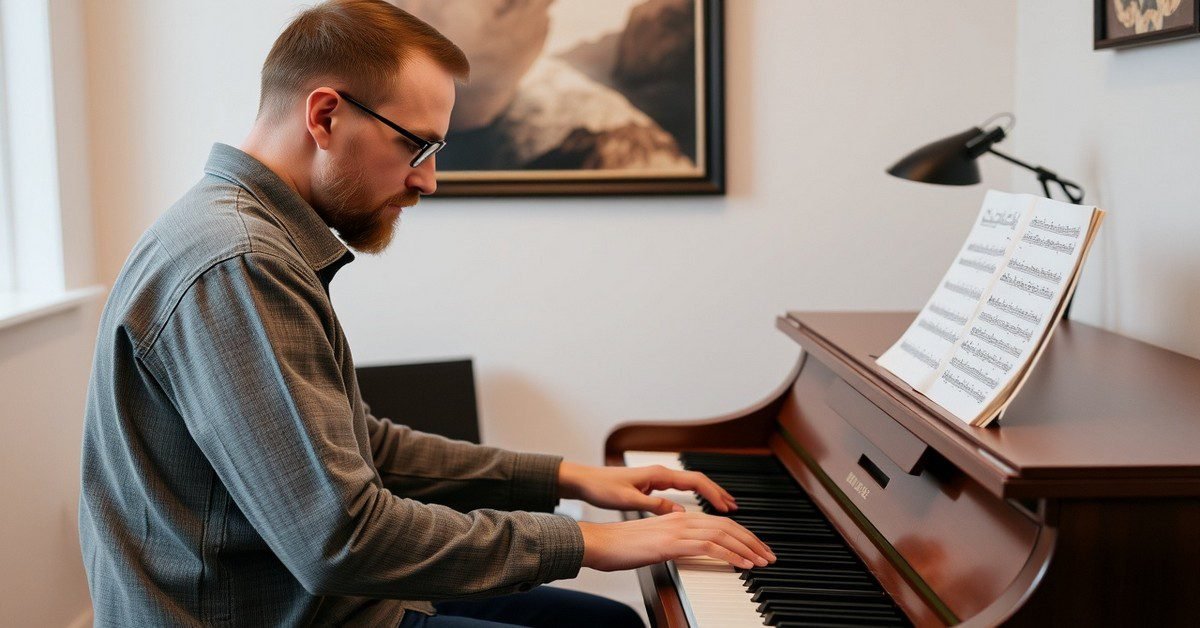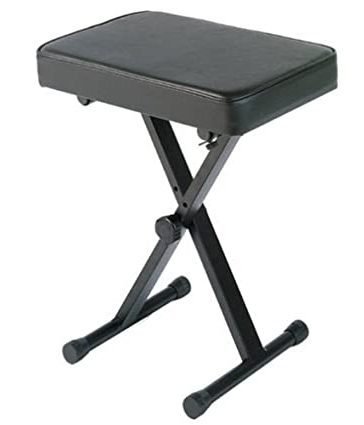Welcome back! Proper Posture and Hand Positioning for Piano Playing is the second post in the piano tutorial for beginners series.
In our first post in the piano tutorial for beginners series, we learned about the piano and keyboard, their differences, parts, and tips on choosing the right instrument for your musical journey. The link for that post is:
Introduction to the Piano and Keyboard
Today, we’re going to learn how to sit at the piano and how to place our hands and fingers on the keys.
Good posture not only helps us play better and have more fun, but it is also important for avoiding any aches or pains. Let’s get started!

Proper Posture and Hand Positioning
Have you ever wondered how professional pianists move their their fingers on the piano keys so easily and play so beautifully?
The reason they can play so smoothly is not just because they practice a lot, but also because they use the right body position and hand placement.
In this post, we will talk about everything you need to know, like:
– how to sit correctly at the piano,
– how to place your hands and fingers, and
– how to move your hands and wrists easily.
Let’s make your piano practice sessions not only more effective but also more enjoyable.
Why Is Posture Important?
When you play the piano, your body helps you make music. Sitting the right way and using your hands correctly can:
- Make Playing Easier: Good posture helps your fingers move smoothly over the keys.
- Prevent Pain: Avoid hurting your back, shoulders, or wrists.
- Improve Sound: Proper hand position helps you press the keys better, making nicer sounds.
- Build Good Habits: Starting with the right posture helps you as you learn more difficult pieces later on.
How to Sit at the Piano

1. Finding the Right Seat
- Use a Piano Bench: If you have one, a piano bench is best. If not, choose a sturdy chair without arms.
- Adjust the Height: Your bench should be at a height where your arms are level with the keys.

2. Positioning Yourself
- Sit Up Straight: Keep your back straight but not stiff. Imagine a string pulling you gently upward.
- Center Yourself: Sit in front of the middle of the keyboard. This is usually around middle C.
- Distance from the Piano:
- Too Close: Your elbows will be behind your body.
- Too Far: You’ll have to stretch your arms out too much.
- Just Right: Your elbows should be slightly in front of your body.
3. Feet Placement
- Flat on the Floor: Place your feet flat on the ground.
- Avoid Crossing Legs: Keep both feet side by side.
- Pedals: If you’re ready to use pedals, your right foot will be on or near them.
Hand and Finger Positioning
1. Curved Fingers
- Natural Curve: Let your fingers curve naturally, like when you gently hold a ball or an apple.
- Tips of Fingers: Play the keys with the tips of your fingers, not the flat parts.
2. Thumb Position
- Relaxed Thumb: Your thumb should rest lightly on the keys.
- Not Too Far Under: Don’t tuck your thumb under your hand.
- Not Sticking Out: Avoid pointing your thumb away from your hand.
3. Wrist Position
- Level Wrists: Keep your wrists straight, not bent up or down.
- Loose and Relaxed: Don’t hold your wrists too stiffly.
4. Arm and Elbow
- Elbows Slightly Away from Body: Not pressing against your sides, but not sticking out too far.
- Shoulders Relaxed: Let your shoulders drop naturally.
Finger Numbers
In piano, each finger has a number. Knowing these helps you follow instructions and sheet music (if you choose to use it later).
- Thumb: Finger 1
- Index Finger: Finger 2
- Middle Finger: Finger 3
- Ring Finger: Finger 4
- Little Finger (Pinky): Finger 5
Use these numbers to help you remember which fingers to use on which keys.
Common Posture Mistakes to Avoid
1. Slouching
- Problem: Sitting hunched over can cause back pain and make it harder to reach the keys. So, use a height adjustable keyboard padded stool bench for piano and keyboard.
- Solution: Sit up straight with your back gently stretched.
2. Tension in Shoulders
- Problem: Raised or tight shoulders can lead to muscle strain.
- Solution: Keep shoulders relaxed and down.
3. Wrists Too High or Low
- Problem: Bending wrists up or down can cause discomfort.
- Solution: Keep wrists straight and level with your hands.
4. Flat Fingers
- Problem: Playing with flat fingers makes it harder to move quickly and accurately.
- Solution: Curve your fingers and use the tips to press the keys.
5. Feet Dangling
- Problem: If your feet don’t touch the floor, it can affect your balance.
- Solution: Use a footstool if needed to keep feet flat.
Tips for Practicing Good Posture
1. Mirror Check
- Use a Mirror: Place a mirror next to your piano to see yourself as you play.
- Watch for:
- Straight back
- Relaxed shoulders
- Level wrists
2. Deep Breaths
- Relaxation: Take deep breaths to release tension.
- Focus: Breathing helps you focus on playing.
3. Stretch Before Playing
- Warm-Up: Gently stretch your fingers, wrists, and arms.
- Examples:
- Shake out your hands.
- Roll your shoulders.
4. Short Breaks
- Rest: Take short breaks if you’re practicing for a long time.
- Stand Up: Move around to keep your body relaxed.
Learning to Move Hands on the Keyboard
1. Sliding Hands
- Stay Close: Keep your hands close to the keys as you move.
- Don’t Lift Too High: Avoid lifting your hands too far from the keyboard.
2. Crossing Hands
- Advanced Technique: Sometimes you need to cross one hand over the other.
- Practice Slowly: Try this slowly to keep good posture.
Developing Finger Strength and Flexibility
1. Finger Exercises
- Five-Finger Patterns: Play up and down five notes with each hand.
- Focus on Control: Press each key carefully.
2. Scales
- What Are They? A series of notes played in order, like C-D-E-F-G-A-B-C.
- Benefits:
- Builds finger strength.
- Helps with hand positioning.
3. Hanon Exercises
- Simple Patterns: These exercises are designed to improve finger agility.
- Consistency: Practice them regularly for best results.
Making It Fun
1. Play Games
- Simon Says: Have someone call out finger numbers, and you press keys with that finger.
- Find the Note: Try to find different notes on the keyboard using the correct finger.
2. Use Simple Songs
- Easy Tunes: Start with songs like “Mary Had a Little Lamb.”
- Focus on Posture: While playing, pay attention to your sitting and hand position.
Remember: Patience Is Key
Learning proper posture and hand positioning might feel tricky at first. That’s okay!
- Take It Slow: Focus on one thing at a time.
- Ask for Help: If you have a teacher or someone who plays piano, ask them to watch you.
- Practice Regularly: The more you practice, the more natural it will feel.
A Quick Recap
- Sit up straight with a relaxed back and shoulders.
- Position yourself so your arms are level with the keyboard.
- Keep your feet flat on the floor.
- Curve your fingers and use the finger tips to press the keys.
- Maintain straight wrists, not bent up or down.
- Keep your elbows slightly away from your body.
- Relax and enjoy playing!
Final Thoughts on Proper Posture and Hand Positioning
Having the right posture and hand position is like building a strong foundation for a house. It supports everything else you do when playing the piano. By making sure you sit properly and use your hands the right way, you’re setting yourself up for success.
Remember, even the best pianists started just like you. They took the time to learn how to sit and move their hands. With practice and patience, you’ll find that good posture becomes natural. Soon, you’ll be playing songs with ease and confidence.
So next time you sit down at the piano, take a moment to check your posture and hand position. Your body will thank you, and your music will sound even better.
Conclusion
Great job today! You now know how to sit properly at the piano and how to position your hands. Remember to keep practicing good posture.
In our next lesson, we’ll explore the keyboard. We’ll learn the names of the keys and find patterns on the piano. Can’t wait to see you then! Happy playing!
Next.. >> Piano Tutorial – 03
Piano Tutorial – 03
Piano Notes for Songs
- Angels Like You - Miley Cyrus
- Chiquitita - ABBA
- Perfect - Ed Sheeran (Easy)
- Shape of You - Ed Sheeran
- Can't Help Falling In Love - Elvis Presley (Easy)
- Faded - Alan Walker - Notes and Chords (Updated)
- A Million Dreams - The Greatest Showman (Easy - Updated)
- Mamma Mia - ABBA
- Everything I Do, I Do It for You - Bryan Adams
- A Sky Full of Stars - Coldplay (Notes and Chords)
- Diamonds - Rihanna
- Demons - Imagine Dragons
- Used To Be Young - Miley Cyrus
- Fairytale - Alexander Rybak
- You Are Not Alone - Michael Jackson
- Let It Be - The Beatles
- Believer - Imagine Dragons (Melody and Chords)
- The Winner Takes It All - ABBA
- My Heart Will Go On - Celine Dion (Easy - Melody and Chords)
- The Scientist - Coldplay
Easy Piano Songs For Beginners
- Can't Help Falling In Love - Elvis Presley (Easy)
- A Million Dreams - The Greatest Showman (Easy - Updated)
- Twinkle Twinkle Little Star
- We Wish You A Merry Christmas
- Christmas Song: Jingle Bells
- A Sky Full of Stars - Coldplay (Notes and Chords)
- Let It Be - The Beatles
- My Heart Will Go On - Celine Dion (Easy - Melody and Chords)
- Yesterday - The Beatles (Easy for Beginners)
- Thunder - Imagine Dragons (Easy)
- The Scientist - Coldplay
- Birthday Song - Happy Birthday to You
- Imagine - John Lennon
- Wings - Birdy (Very Easy)
- Yellow - Coldplay (Easy)
- The Wheels on the Bus - Kids Song
- Take Me Home, Country Roads - John Denver (Easy)
- Row, Row, Row Your Boat - Song for Children
- What a Wonderful World - Louis Armstrong
- Dame tu Cosita - El Chombo
Piano Notes
- Dynamite - BTS
- Say Something - A Great Big World - Christina Aguilera
- Scars to Your Beautiful - Alessia Cara
- Into You - Ariana Grande
- Earth Song - Michael Jackson
- Water Under the Bridge - Adele
- Lego House - Ed Sheeran
- Daylight - David Kushner
- Can I Be Him - James Arthur
- Merry Christmas - Ed Sheeran and Elton John
- Hard to Love - BLACKPINK
- 7 Rings - Ariana Grande
- Too Good at Goodbyes - Sam Smith
- Unstoppable - Sia
- Ocean Eyes - Billie Eilish
- Reflection - Alexander Stewart
- Don't Matter - Akon
- Espresso - Sabrina Carpenter
- Shadow of Mine - Alec Benjamin
- Fortnight - Taylor Swift